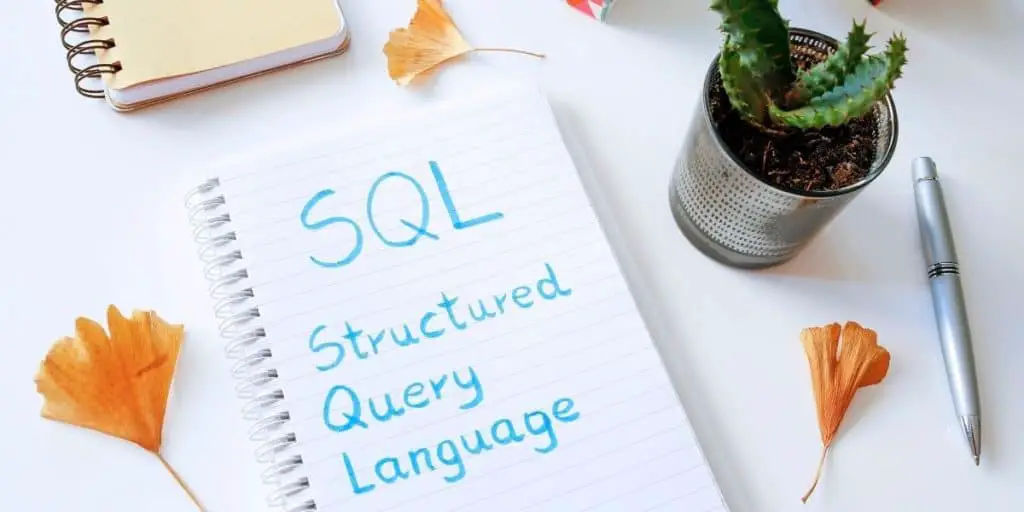If you are planning on a career in data analysis, data modeling, machine learning, or data science, SQL and Python are two languages that can be very beneficial. But, the question is, which one is easier to learn?
SQL is easier than Python, in broad terms, since it has a shorter learning curve. However, for complex data workflows, limiting yourself solely to SQL over Python can make some executions more difficult. SQL is easier if all you need are JOIN, subquery, and aggregate functions.
If you are in a position where you need to weigh the value of learning SQL over Python based on simplicity, read on. This article will cover why SQL can be easier than Python in certain use case scenarios.
Important Sidenote: We interviewed numerous data science professionals (data scientists, hiring managers, recruiters – you name it) and identified 6 proven steps to follow for becoming a data scientist. Read my article: ‘6 Proven Steps To Becoming a Data Scientist [Complete Guide] for in-depth findings and recommendations! – This is perhaps the most comprehensive article on the subject you will find on the internet!
Table of Contents
Ease Over Simplicity
SQL and Python are considered good value propositions for the amount of time required to gain proficiency in them and the value you get out of them.

However, when analyzing computer languages such as SQL and Python to determine which is easiest to learn, it is crucial to distinguish between ease and simplicity.
SQL
SQL is a query language. It is currently the de facto standard for querying and managing relational database management systems. The syntax used for queries is straightforward. Also, it is semantically friendly. Being so makes getting started with SQL a lot easier for people who may not have a profound background in programming or coding.
While being well suited for querying databases, when more complex actions are needed in modifying data, SQL alone may not be enough.
Python
Unlike SQL, Python is not limited to querying a database. It is considered a general programming language. That means that the range of functionality that it has is far more extensive than that of SQL.
As would be expected, having a broader range of uses, the learning curve will be longer. However, this does not mean that it is more challenging to learn. The syntax used in Python is unique and focused on readability. Also, it is not dependent on other languages. It is considered to be a high-level language.
The latter means that it is more user friendly and that it is independent of hardware architecture. As a result, you are able to focus more on the functionality you are attempting to achieve. Python is less convoluted than other programming languages such as C++ or Java.
Why SQL Is Easier To Learn Versus Python?
It is not uncommon to read assertions that reduce the question of what language is easier to learn between SQL and Python to a straightforward premise. This premise is that since Python is a full-fledged programming language and SQL is primarily a querying language, by default, the latter will be simpler to master.
While there are some caveats, this premise is essentially correct. However, it also oversimplifies the reason for SQL being easier than Python to master.
When you compare both languages to determine where you should invest your time and money to improve your professional skillset, it is essential to be comprehensive. These are four key reasons why SQL is easier than Python.
SQL Is a Declarative Language
One of the factors that determine the ease of learning of any computer language involves the type of language. There are four main types of programming languages. These include procedural (also known as imperative), object-oriented, functional, and declarative.
SQL is a declarative language—it is non-procedural. You can write queries only by focusing on the result you want to obtain and not on the method or steps involved in arriving at it. In other words, SQL allows you to focus on the water and not the house.
In contrast, a general programming language such as Python is procedural. It requires you to code not only what you need or want to accomplish but also how it is to be done.
To clarify this significant difference in language types, imagine if you had to code common everyday tasks such as going to the store for milk. Using procedural languages, you would have to write out a sequence similar to this.
- Walk to your door.
- Open your door.
- Walk to your car.
- Open your car door.
- Enter your car.
- Start your car.
- Drive to the supermarket.
- Park your vehicle.
- Turn off the engine and exit your vehicle.
- Walk to the supermarket entrance.
- Enter the store.
- Walk to the dairy section.
- Grab a gallon of milk.
- Walk to the cashier.
- Pay for the milk.
- Drive back home.
As you can see, a simple task such as picking up a gallon of milk when it has to be written out in procedural format becomes complex and tedious. Extending this analogy to SQL, coding the same action would look like this.
- Go to the store for milk.
This stark difference between procedural and declarative programming languages means that you need to learn fewer SQL commands. It also means that the coding structure can be significantly more simplified. Both of these attributes make learning SQL easier.
There Is No Rigid Formatting In SQL
SQL does not have a rigid formatting requirement. In other words, when you write code for a query with SQL, formatting slip-ups should not affect the execution of the query.
Even though there isn’t a formatting requirement for SQL, it is essential to maintain a consistent style. Such is the case with any programming language. A consistent and clean style is helpful when reviewing code and developing new processes.
With SQL, some rules and conventions are in place. They can be found in SQL style guides from database vendors, companies, standardization organizations, etc.
Instead of making SQL needlessly complicated, the style guides help make SQL queries flow more naturally from the conceptualization stage to the actual coding. It makes for an already easy language to be more semantically friendly.
SQL Is a Narrow Language
SQL is a narrow language. By this, we mean that the queries written in SQL rely primarily on four functions; joins, aggregate subqueries, and window functions.
On the other hand, Python has many libraries that you can draw upon for specialized functionality. For example, you can use pandas for data analysis functionality and scikit-learn for machine learning applications.
While you can argue that relying on a narrow set of functions can be limiting, it should also be mentioned that this makes gaining proficiency in SQL a faster and less stressful process.
Many professionals using SQL, such as those involved with data analysis, may never need Python and its libraries’ complexity. Even those who use SQL in more advanced endeavors such as data science, database architecture, and machine learning, will still find that a vast portion of their workflow can be accomplished with standard SQL.

SQL Query Creation Is Human-Friendly
When creating queries with SQL, the workflow develops along a linear path. It involves aggregating and joining data from more extensive data sets and continues until it delivers the result requested.
Even when the queries are long, they still retain linearity that makes modeling them mentally manageable.
With Python, working with data involves a more fluid process. It consists of breaking a data set into smaller units, with each of them becoming an independent thread for analysis. Afterward, you will need to combine those threads and later separate them once again to fulfill your analytical query.
By being fluid as opposed to linear, using Python opens up the possibility for more complexity. However, it also makes grasping mentally the entirety of your workflow more difficult.
That is why SQL and its linear way of coming together in workflows are much easier and faster to dominate.
Author’s Recommendations: Top Data Science Resources To Consider
Before concluding this article, I wanted to share few top data science resources that I have personally vetted for you. I am confident that you can greatly benefit in your data science journey by considering one or more of these resources.
- DataCamp: If you are a beginner focused towards building the foundational skills in data science, there is no better platform than DataCamp. Under one membership umbrella, DataCamp gives you access to 335+ data science courses. There is absolutely no other platform that comes anywhere close to this. Hence, if building foundational data science skills is your goal: Click Here to Sign Up For DataCamp Today!
- IBM Data Science Professional Certificate: If you are looking for a data science credential that has strong industry recognition but does not involve too heavy of an effort: Click Here To Enroll Into The IBM Data Science Professional Certificate Program Today! (To learn more: Check out my full review of this certificate program here)
- MITx MicroMasters Program in Data Science: If you are at a more advanced stage in your data science journey and looking to take your skills to the next level, there is no Non-Degree program better than MIT MicroMasters. Click Here To Enroll Into The MIT MicroMasters Program Today! (To learn more: Check out my full review of the MIT MicroMasters program here)
- Roadmap To Becoming a Data Scientist: If you have decided to become a data science professional but not fully sure how to get started: read my article – 6 Proven Ways To Becoming a Data Scientist. In this article, I share my findings from interviewing 100+ data science professionals at top companies (including – Google, Meta, Amazon, etc.) and give you a full roadmap to becoming a data scientist.
Conclusion
SQL is easier to learn than Python. The learning curve for SQL is not as intense. The syntax and commands used in SQL are fewer than in Python.
Being a declarative language based on a narrow set of functions that is forgiving with regards to formatting, SQL is ideal as a first language to learn.
BEFORE YOU GO: Don’t forget to check out my latest article – 6 Proven Steps To Becoming a Data Scientist [Complete Guide]. We interviewed numerous data science professionals (data scientists, hiring managers, recruiters – you name it) and created this comprehensive guide to help you land that perfect data science job.
Affiliate Disclosure: We participate in several affiliate programs and may be compensated if you make a purchase using our referral link, at no additional cost to you. You can, however, trust the integrity of our recommendation. Affiliate programs exist even for products that we are not recommending. We only choose to recommend you the products that we actually believe in.
Recent Posts
Data science has been a buzzword in recent years, and with the rapid advancements in artificial intelligence (AI) technologies, many wonder if data science as a field will be replaced by AI. As you...
In the world of technology, there's always something new and exciting grabbing our attention. Data science and analytics, in particular, have exploded onto the scene, with many professionals flocking...
